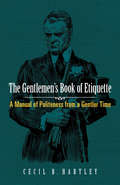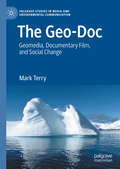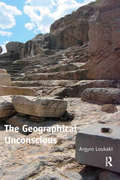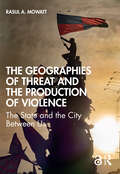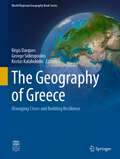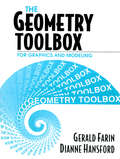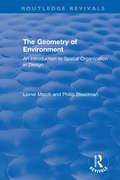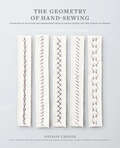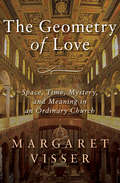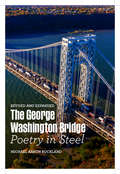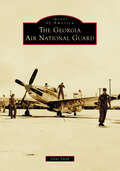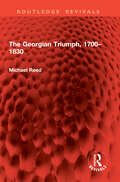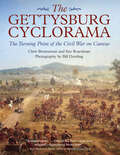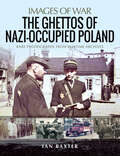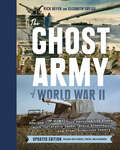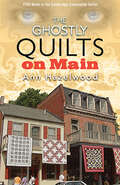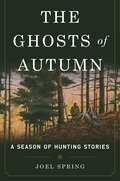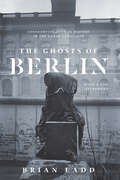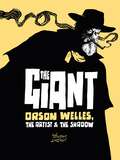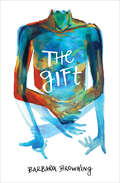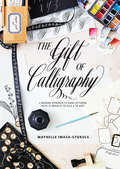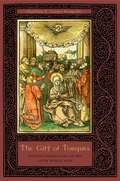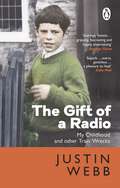- Table View
- List View
The Gentlemen's Book of Etiquette: A Manual of Politeness from a Gentler Time
by Cecil B. HartleyWhat should you do if you find a bug on your plate? How do you ask someone to dance? What's the least offensive way to enjoy your cigar? These and other questions of social decorum are answered in this classic etiquette book. Published just before the Civil War, this volume offers enduring advice for courtesy-challenged men. Common-sense suggestions for socializing, exercise, flirting, dining, and dressing reveal that the basics of proper behavior haven't changed all that much ― and in situations where they have, today's gentlemen may find something worth learning from their predecessors.Suggestions for the best way to behave, as well as how not to behave, include conduct in the street ("Avoid striking your umbrella against those which pass you"); making calls ("No man in the United States, excepting His Excellency, the President, can expect to receive calls unless he returns them"); and dating ("Any lover-like airs or attitudes, although you may have the right to assume them, are in excessively bad taste in public"). These and other etiquette tips provide intriguing glimpses of nineteenth-century society in addition to a wealth of timeless counsel on behaving with sincerity, dignity, and kindness in our own day and age.
The Geo-Doc: Geomedia, Documentary Film, and Social Change (Palgrave Studies in Media and Environmental Communication)
by Mark TerryThis book introduces a new form of documentary film: the Geo-Doc, designed to maximize the influential power of the documentary film as an agent of social change. By combining the proven methods and approaches as evidenced through historical, theoretical, digital, and ecocritical investigations with the unique affordances of Geographic Information System technology, a dynamic new documentary form emerges, one tested in the field with the United Nations. This book begins with an overview of the history of the documentary film with attention given to how it evolved as an instrument of social change. It examines theories surrounding mobilizing the documentary film as a communication tool between filmmakers and policymakers. Ecocinema and its semiotic storytelling techniques are also explored for their unique approaches in audience engagement. The proven methods identified throughout the book are combined with the spatial and temporal affordances provided by GIS technology to create the Geo-Doc, a new tool for the activist documentarian.
The Geographical Unconscious
by Argyro LoukakiThis ambitious and innovative volume stretches over time and space, over the history of modernity in relation to antiquity, between East and West, to offer insights into what the author terms the 'geographical unconscious.' She argues that, by tapping into this, we can contribute towards the reinstatement of some kind of morality and justice in today's troubled world. Approaching selected moments from ancient times to the present of Greek cultural and aesthetic geographies on the basis of a wide range of sources, the book examines diachronic spatiotemporal flows, some of which are mainly cultural, others urban or landscape-related, in conjunction with parallel currents of change and key issues of our time in the West more generally, but also in the East. In doing so, The Geographical Unconscious reflects on visual and spatial perceptions through the ages; it re-considers selective affinities plus differences and identifies enduring age-old themes, while stressing the deep ancient wisdom, the disregarded relevance of the aesthetic, and the unity between human senses, nature, and space. The analysis provides new insights towards the spatial complexities of the current age, the idea of Europe, of the East, the West, and their interrelations, as well as the notion of modernity.
The Geographies of Threat and the Production of Violence: The State and the City Between Us
by Rasul A MowattThe Geographies of Threat and the Production of Violence exposes the spatial processes of racialising, gendering, and classifying populations through the encoded urban infrastructure – from highways cleaving neighbourhoods to laws and policies fortifying even more unbreachable boundaries. This synthesis of narrative and theory resurrects neglected episodes of state violence and reveals how the built environment continues to enable it today within a range of cities throughout the world. Examples and discussions pull from colonial pasts and presents, of old strategic settlements turned major modern cities in the United States and elsewhere that link to the physical and legal structures concentrating a populace into neighbourhoods that prep them for a lifetime of conscripted and carceral service to the State.
The Geography of Greece: Managing Crises and Building Resilience (World Regional Geography Book Series)
by Régis Darques George Sidiropoulos Kostas KalabokidisDuring the last few years, Greece has become a subject of increasing attention worldwide. Once praised for its ability to innovate and reform during the EU integration process, applauded for its remarkable job in managing the 2004 Olympics, the country fell into a financial crisis of unprecedented magnitude in 2008. Much has been said on this matter, and amid the morass of information a staggering number of untruths have been disseminated.In fact, the challenges of vulnerability and the paradigms of adaptation go way beyond finance and economy in Greece. Mega-fires, earthquakes, landslides and floods, migrations, sociopolitical upheavals, and armed conflicts generate emergency situations repeatedly. Because of its bridging role between natural and social sciences, geography can provide insights into the entire breadth of hazardous and chaotic events driving adaptation and change. Against all these threats, Greece has developed an enhanced resilience capacity. The purpose of this book is to help unravel the complexities of a fascinating country beyond clichés.This book is intended for students, researchers, scholars, and engineers interested in geography, land planning, urban studies, and environmental management. The crises issue intended as a guideline allows widening the audience to include the media, governmental and non-governmental agencies, and the public at large.
The Geometry Toolbox for Graphics and Modeling
by Gerald Farin Dianne HansfordThe Geometry Toolbox takes a novel and particularly visual approach to teaching the basic concepts of two- and three-dimensional geometry. It explains the geometry essential for today's computer modeling, computer graphics, and animation systems. While the basic theory is completely covered, the emphasis of the book is not on abstract proofs but rather on examples and algorithms. The Geometry Toolbox is the ideal text for professionals who want to get acquainted with the latest geometric tools. The chapters on basic curves and surfaces form an ideal stepping stone into the world of graphics and modeling. It is also a unique textbook for a modern introduction to linear algebra and matrix theory.
The Geometry of Environment: An Introduction to Spatial Organization in Design (Routledge Revivals)
by Philip Steadman Lionel MarchOriginally published in 1971 The Geometry of Environment is a fusion of art and mathematics introducing stimulating ideas from modern geometry, using illustrations from architecture and design. The revolution in the teaching of mathematics and the advent of the computer in design challenge traditional ways of appreciating the space about us, and expand the ‘structural’ understanding of our surroundings through such concepts as transformations, symmetry groups, sets and graphs. This book aims to show the relevance of ‘new maths’ and encourages exploration of the widening intellectual horizons of environmental design and architecture.
The Geometry of Hand-Sewing: A Romance in Stitches and Embroidery from Alabama Chanin and The School of Making (Alabama Studio Ser.)
by Natalie ChaninThis sewing guide reveals a breakthrough method to simplify learning stitches of all kinds, with more than 100 stitches from the simple to the fanciful.As makers, we tend to learn different stitches over time without thinking much about how they relate to one another. But when Natalie Chanin and her teams at Alabama Chanin and The School of Making began to look at needlework closely, they realized all stitches are based on geometric grid systems. They also discovered that learning new stitches—even elaborate ones—became simple and easy when using grids as guides. In The Geometry of Hand-Sewing Chanin presents their breakthrough method, featuring illustrated instructions (for both right- and left-handed stitchers) for more than 100 stitches—from the basic straight and chain to complex feather and herringbone. Photos of both right and wrong sides are included, as well as guidelines for modifying stitches to increase one’s repertoire further. The book also offers downloads for two stitching cards with the grids on which every stitch in the book is based. These printable cards can be used as stencils for transferring grids to fabric.
The Geometry of Love: Space, Time, Mystery, and Meaning in an Ordinary Church
by Margaret VisserThis enthralling study of the church of St. Agnes Outside the Walls brings to vivid life the stories, rituals, and architectural meaning contained within this seventeen-hundred-year-old building In The Geometry of Love, acclaimed author Margaret Visser, the preeminent "anthropologist of everyday life," takes on the living history of the ancient church of St. Agnes. Examining every facet of the building, from windows to catacombs, Visser takes readers on a mesmerizing tour of the old church, covering its social, political, religious, and architectural history. In so doing, she illuminates not only the church's evolution but also its religious legacy in our modern lives. Written as an antidote to the usual dry and traditional studies of European churches, The Geometry of Love is infused with Visser's unmatched warmth and wit, celebrating the remarkable ways that one building can reveal so much about our history and ourselves.
The George Washington Bridge: Poetry in Steel
by Michael Aaron RocklandSince opening in 1931, the George Washington Bridge, linking New York and New Jersey, has become the busiest bridge in the world, with 103 million vehicles crossing it in 2016. Many people also consider it the most beautiful bridge in the world, yet remarkably little has been written about this majestic structure. Intimate and engaging, this revised and expanded edition of Michael Rockland's rich narrative presents perspectives on the GWB, as it is often called, that span history, architecture, engineering, transportation, design, the arts, politics, and even post-9/11 mentalities. This new edition brings new insight since its initial publication in 2008, including a new chapter on the infamous “Bridgegate” Chris Christie-era scandal of 2013, when members of the governor's administration shut down access to the bridge, causing a major traffic jam and scandal and subsequently helping undermine Christie’s candidacy for the US presidency. Stunning photos, from when the bridge was built in the late 1920s through the present, are a powerful complement to the bridge's history. Rockland covers the competition between the GWB and the Brooklyn Bridge that parallels the rivalry between New Jersey and New York City. Readers will learn about the Swiss immigrant Othmar Ammann, an unsung hero who designed and built the GWB, and how a lack of funding during the Depression dictated the iconic, uncovered steel beams of its towers, which we admire today. There are chapters discussing accidents on the bridge, such as an airplane crash landing in the westbound lanes and the sad story of suicides off its span; the appearance of the bridge in media and the arts; and Rockland's personal adventures on the bridge, including scaling its massive towers on a cable. Movies, television shows, songs, novels, countless images, and even PlayStation 2 games have aided the GWB in becoming a part of the global popular culture. This tribute will captivate residents living in the shadow of the GWB, the millions who walk, jog, bike, skate, or drive across it, as well as tourists and those who will visit it someday. .
The Georgia Air National Guard (Images of America)
by Clint SmithThe Georgia Air National Guard units in Marietta, Savannah, Warner Robins, and other locations have played a role in major conflicts around the world. Clint Smith, a retired member of the Georgia Air National Guard uses images from the Georgia National Guard history office and the Historical Society of the Georgia National Guard to illustrate its history since the guard's official creation in 1947. The founder of the colony of Georgia, Gen. James Oglethorpe, served as the first Georgia Guardsman. He embodied the legend of the minuteman, a tradition carried forward by the Georgia Army National Guard. In May 1941, the first distinct aviation unit was created at Candler Field in Atlanta--the 128th Observation Squadron. In September 1947, a federal act officially created the Air National Guard. Clint Smith served at state headquarters at Dobbins Air Reserve Base in Marietta, Georgia. He had many responsibilities, including command historian. A board member of the Historical Society of the Georgia National Guard, Smith served eight years in the Georgia Legislature, where he led on military and security issues. The author of two novels, Smith has published columns on public policy and history.
The Georgian Triumph, 1700–1830 (Routledge Revivals)
by Michael ReedIn The Georgian Triumph, 1700–1830 (originally published in 1983), Michael Reed re-creates the ambience of eighteenth-century Britain, a period of astonishing change and, paradoxically, of massive stability. Both the change and the stability were reflected in the landscape.Dr Reed explores the visual impact on the landscape of the adoption of new ideas and practices. These range from the acceptance of the Palladian style of architecture and its gradual replacement by a taste for Gothic, Picturesque or Chinese designs, to the practical exploration of the power of atmospheric pressure and improvements in road-making techniques and the design of water wheels. He describes the ‘feel’ of what it must have been like to live through the years which saw the beginning of the end for the old, medieval society, and the birth of a modern industrial nation. Traditional ways of life were slowly abandoned as ancient open fields were enclosed and divided up by straight roads and hedgerows. Changes in the moral climate led to the gradual disappearance of village feasts and the suppression of cockfighting and bull-running, while other, more acceptable, pastimes such as horse-racing and cricket acquired rules and institutions.The book shows that these changes were brought about by people at work and at play; going about their everyday affairs, they wrote and re-wrote upon the landscape the autobiography of the society of which they formed a part, reflecting its aspirations, ideals and achievements.
The Gettysburg Cyclorama: The Turning Point of the Civil War on Canvas
by Chris Brenneman Sue BoardmanThousands of books and articles have been written about the Battle of Gettysburg. Almost every topic has been thoroughly scrutinized except one: Paul Philippoteaux’s massive cyclorama painting The Battle of Gettysburg, which depicts Pickett’s Charge, the final attack at Gettysburg. The Gettysburg Cyclorama: The Turning Point of the Civil War on Canvas is the first comprehensive study of this art masterpiece and historic artifact. This in-depth study of the history of the cyclorama discusses every aspect of this treasure, which was first displayed in 1884 and underwent a massive restoration in 2008. Coverage includes not only how it was created and what it depicts, but the changes it has undergone and where and how it was moved. Authors Chris Brenneman and Sue Boardman also discuss in fascinating detail how the painting was interpreted by Civil War veterans in the late 19th Century. With the aid of award-winning photographer Bill Dowling, the authors utilized modern photography to compare the painting with historic and modern pictures of the landscape. Dowling’s remarkable close-up digital photography allows readers to focus on distant details that usually pass unseen. Every officer, unit, terrain feature, farm, and more pictured in the painting is discussed in detail. Even more remarkable, the authors reveal an important new discovery made during the research for this book: in order to address suggestions from the viewers, the cyclorama was significantly modified five years after it was created to add more soldiers, additional flags, and even General George Meade, the commander of the Union Army! With hundreds of rare historic photographs and beautiful modern pictures of a truly great work of art, The Gettysburg Cyclorama: The Turning Point of the Civil War on Canvas is a must-have for anyone interested in the Battle of Gettysburg or is simply a lover of exquisite art.
The Ghettos of Nazi-Occupied Poland: Rare Photographs From Wartime Archives (Images of War)
by Ian BaxterThis pictorial history presents a vivid and harrowing exploration of Jewish ghettos during the Nazi occupation of Poland during WWII.Following the 1940 invasion of Poland, the Nazis established ghettos in cities and towns across the country with the initial aim of isolating the Jewish community. These closed sectors were referred to as Judischer Wohnbezirk or Wohngebiet der Juden (Jewish Quarters). Drawing on a wealth of historical images, this volume shows the harsh and deteriorating conditions of daily life in these restricted areas. In reality, these ghettos were holding areas where Jews were kept before being transferred to concentration, extermination, and work camps. Aware of their imminent fate, which included the threat of family separation, enslavement, and death, underground resistance groups sprung up staged numerous uprisings which were brutally and callously suppressed.The Nazis’ ultimate aim was the liquidation of the ghettos and the extermination of their inhabitants in furtherance of The Final Solution. This may seem unthinkable today but, as this book graphically reveals, they worked to achieve their objective regardless of human suffering.
The Ghost Army of World War II: How One Top-Secret Unit Deceived the Enemy with Inflatable Tanks, Sound Effects, and Other Audacious Fakery (Updated Edition)
by Rick Beyer Elizabeth Sayles"A riveting tale told through personal accounts and sketches along the way—ultimately, a story of success against great odds. I enjoyed it enormously." —Tom BrokawThe first book to tell the full story of how a traveling road show of artists wielding imagination, paint, and bravado saved thousands of American lives—now updated with new material.In the summer of 1944, a handpicked group of young GIs—artists, designers, architects, and sound engineers, including such future luminaries as Bill Blass, Ellsworth Kelly, Arthur Singer, Victor Dowd, Art Kane, and Jack Masey—landed in France to conduct a secret mission. From Normandy to the Rhine, the 1,100 men of the 23rd Headquarters Special Troops, known as the Ghost Army, conjured up phony convoys, phantom divisions, and make-believe headquarters to fool the enemy about the strength and location of American units. Every move they made was top secret, and their story was hushed up for decades after the war's end.Hundreds of color and black-and-white photographs, along with maps, official memos, and letters, accompany Rick Beyer and Elizabeth Sayles’s meticulous research and interviews with many of the soldiers, weaving a compelling narrative of how an unlikely team carried out amazing battlefield deceptions that saved thousands of American lives and helped open the way for the final drive to Germany. The stunning art created between missions also offers a glimpse of life behind the lines during World War II. This updated edition includes:A new afterword by co-author Rick BeyerNever-before-seen additional imagesThe successful campaign to have the unit awarded a Congressional Gold Medal History and WWII enthusiasts will find The Ghost Army of World War II an essential addition to their library.
The Ghostly Quilts on Main (Colebridge Community Series)
by Ann Hazelwood“A light, fun read . . . Hazelwood does a great job of keeping your interest as you wonder what each ghost might do. Her characters are well developed.” —Journal-AdvocateIn this fifth novel of the Colebridge Community Series, busy flower shop owner Anne Brown Dickson takes on the task of helping fellow shop owners on Main Street. A unique quilt show develops that impacts the street throughout the fall and winter season. In the process, Anne is reluctantly assisted by a host of ghostly participants. On the home front, Grandmother initiates some activities of her own that may reap some harmful results. All is not gloom and doom, however, as Anne makes changes to her business and best friend, Nancy, has some upcoming changes of her own.Praise for Ann Hazelwood and the Colebridge Community Series“I found myself immersed in the tale of this extended family and this wonderful quaint town . . . You will laugh, cry and share in their hopes and dreams.” —Community News“Ann Hazelwood knows a few things about the human spirit, family and dreaming big. Add a mixture of the love of quilting and all the things Missouri historic and otherwise; you will experience the words and passion of this unique and gifted author. Enjoy the experience!”—StreetScape Magazine
The Ghosts of Autumn: A Season of Hunting Stories
by Joel Spring"This is my cathedral. These are my meditations. I was raised Methodist, but this is my religion.”"The fields and woods and old orchards here are sacred ground. I feel the presence of my old friends. I am humbled in the face of the beauty of the place and experience the quiet only found in nature. The peace for which we all search envelops me. On my worst days I’ve never failed to find it here.”The Ghosts of Autumn joins Joel Spring for one brief season in the life of an avid outdoorsman. Stories of dogs and deer, friendship and adventure, heartache and triumph are set against a backdrop of the vivid colors of autumn. From the first few wisps of cool north wind in September, through the frigid mountain cold of a late December morning, the author treats you like a welcomed friend.Spring’s carefully crafted prose revisits the ghosts of hundreds of past hunts with good dogs and good friends will appeal not only to avid hunters and outdoorsmen but also anyone who appreciates fine writing about nature. Spend some time with Joel Spring and The Ghosts of Autumn.Skyhorse Publishing is proud to publish a broad range of books for hunters and firearms enthusiasts. We publish books about shotguns, rifles, handguns, target shooting, gun collecting, self-defense, archery, ammunition, knives, gunsmithing, gun repair, and wilderness survival. We publish books on deer hunting, big game hunting, small game hunting, wing shooting, turkey hunting, deer stands, duck blinds, bowhunting, wing shooting, hunting dogs, and more. While not every title we publish becomes a New York Times bestseller or a national bestseller, we are committed to publishing books on subjects that are sometimes overlooked by other publishers and to authors whose work might not otherwise find a home.
The Ghosts of Berlin: Confronting German History in the Urban Landscape
by Brian LaddIn the twenty years since its original publication, The Ghosts of Berlin has become a classic, an unparalleled guide to understanding the presence of history in our built environment, especially in a space as historically contested—and emotionally fraught—as Berlin. Brian Ladd examines the ongoing conflicts radiating from the remarkable fusion of architecture, history, and national identity in Berlin. Returning to the city frequently, Ladd continues to survey the urban landscape, traversing its ruins, contemplating its buildings and memorials, and carefully deconstructing the public debates and political controversies emerging from its past.
The Giant Book of Hacks for Minecrafters: A Giant Unofficial Guide Featuring Tips and Tricks Other Guides Won't Teach You (Hacks for Minecrafters)
by Megan MillerA gigantic guide to command blocks, redstone, mods, and more!The Giant Book of Hacks for Minecrafters teachers Minecrafters everything they need to know about manipulating and programming command blocks within Minecraft, manipulating redstone to make amazing contraptions and machines, how to add modifications to their Minecraft game, and more! Other tips will help gamers: Make their own custom maps and mini-games Build essential redstone logic gates, loops, and circuits Explore today’s range of modded Minecraft play, from the must-haves to the fanciful And much, much more! Packed with expert tips, cheats, and hacks! This guide shows users exactly how the experts wield command blocks and make fun modifications (like giving and getting loot and customizing villagers), wield redstone power and build classic and crazy contraptions (like automatic doors and furnaces, and hidden traps and staircases), and keep their games new and exciting with mods (from utilities to full-fledged gameplay extensions and modpacks). Hundreds of screenshots help readers follow along with each tip, step-by-step, to master the Minecrafting world.
The Giant: Orson Welles, the Artist and the Shadow
by Youssef Daoudi“Gloriously unruly...an incisive look at an artist who never recovered from the success of his youth.” —Publishers WeeklyFrom graphic novelist Youssef Daoudi comes a radically new look at the director of Citizen Kane and Touch of Evil: legendary filmmaker Orson Welles.Long after his death in 1985, the shadow of Orson Welles still looms over Hollywood. By twenty-three, Welles had revolutionized theatre and radio with The War of the Worlds; by twenty-five, he had secured his place in history with his debut film, Citizen Kane. Yet four films and less than a decade later, his career suffered a spectacular collapse, and Welles, once the most promising director in America, was written off as a “would-be genius”—a bad bet in an increasingly money-conscious industry. In The Giant, Youssef Daoudi weaves together reality and mythology to create a radical new look at one of Hollywood’s most legendary figures and poses a question as timeless as Orson Welles himself: What happens when a true artist comes up against the rest of the world?
The Gibson Girl and Her America: The Best Drawings of Charles Dana Gibson (Dover Fine Art, History of Art)
by Charles Dana GibsonAt the turn of the twentieth century, Charles Dana Gibson's pen-and-ink drawings of the "American Girl" -- now remembered as the Gibson Girl -- became the national ideal of femininity. This collection of his images of youthful, dynamic women offers an informative and amusing reflection of the era's social life. Sentimental, humorous, and often gently satirical, these images portray the Gibson Girl at the theater, in the drawing room, flirting and courting, vacationing at the beach, and engaging in other genteel pursuits. Several of Gibson's "common man" illustrations provide a contrast, along with a section devoted to one of the artist's best-known and most beloved characters, the curmudgeonly Mr. Pipp.This gallery features more than a hundred carefully selected images from vintage editions. A rich source of royalty-free art, it offers graphic artists, fashion designers, social historians, and nostalgia lovers a lovely and accurate chronicle of a bygone era.
The Gift (Emily Bks.)
by Barbara BrowningIn the midst of Occupy, Barbara Andersen begins spamming people indiscriminately with ukulele covers of sentimental songs. A series of inappropriate intimacies ensued, including an erotically charged correspondence and then collaboration with an extraordinarily gifted and troubled musician living in Germany.
The Gift of Calligraphy: A Modern Approach to Hand Lettering with 25 Projects to Give and to Keep
by Maybelle Imasa-StukulsAn easy-to-follow guide to learning the art of calligraphy, with 25 gorgeously photographed projects that use calligraphy to make beautiful gifts and home décor.Calligraphy and hand lettering have surged in popularity as people rediscover traditional handicrafts as a creative outlet and way to relax. Unlike other hand lettering books, The Gift of Calligraphy shows you how to use your calligraphy skills to create invitations, wall art, wrapping paper, a tote bag, even a calligraphy kit for kids. Maybelle Imasa-Stukuls, calligraphy teacher and author of Belle Calligraphy, brings her signature modern style to this traditional craft. The first quarter of the book provides a primer for creating a simple alphabet and how to find your own personal style of lettering, followed by wonderful projects that will delight your family, impress your friends, and beautify your home, all accompanied by clear step-by-step photography and inspiring shots of the finished pieces.
The Gift of Tongues: Women's Xenoglossia in the Later Middle Ages
by Christine F. Cooper-RompatoTales of xenoglossia—the instantaneous ability to read, to write, to speak, or to understand a foreign language—have long captivated audiences. Perhaps most popular in Christian religious literature, these stories celebrate the erasing of all linguistic differences and the creation of wider spiritual communities. The accounts of miraculous language acquisition that appeared in the Bible inspired similar accounts in the Middle Ages. Though medieval xenoglossic miracles have their origins in those biblical stories, the medieval narratives have more complex implications. In The Gift of Tongues, Christine Cooper-Rompato examines a wide range of sources to show that claims of miraculous language are much more important to medieval religious culture than previously recognized and are crucial to understanding late medieval English writers such as Geoffrey Chaucer and Margery Kempe.
The Gift of a Radio: My Childhood and other Train Wrecks
by Justin Webb'Searingly honest... gripping... fascinating and hugely entertaining.'- Sunday Times'Moving and frank ... A story of a childhood defined by loneliness, the absence of a father and the grim experience of a Quaker boarding school. It is also one of the most perceptive accounts of Britain in the 1970s.'- Misha Glenny'A crisp, unself-pitying memoir of a 'trainwreck' youth ... I've always likes Webb on the radio. But I like him much more after reading this book. He offers precisely the kind of brisk honesty and considered analysis he expects from his interviewees. Our politicians should all read it, and step up their game.' -Telegraph.........................................................................................................................................................Justin Webb's childhood in the 1970s was far from ordinary.Between his mother's un-diagnosed psychological problems, and his step-father's untreated ones, life at home was dysfunctional at best. But with gun-wielding school masters and sub-standard living conditions, Quaker boarding school wasn't much better.Candid, unsparing and darkly funny, Justin Webb's memoir is as much a portrait of a troubled era as it is the story of a dysfunctional childhood, shaping the urbane and successful radio presenter we know and love now.........................................................................................................................................'I thoroughly enjoyed Justin Webb's bonkers childhood. He captures the middle class of the age with a tenacity only possible in one of its victims.' -Jeremy Paxman
